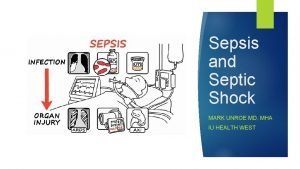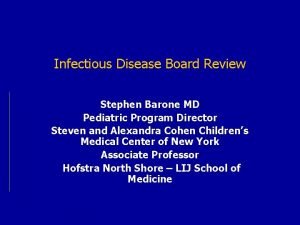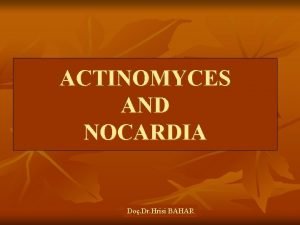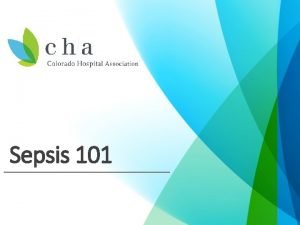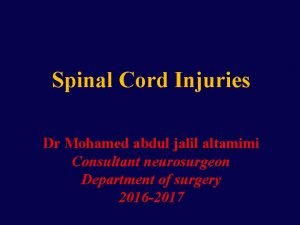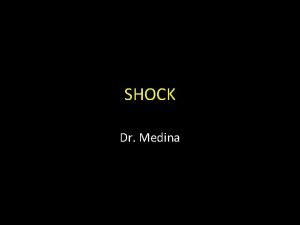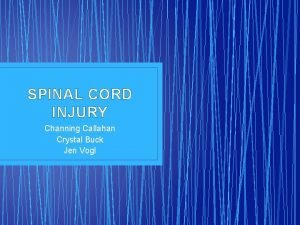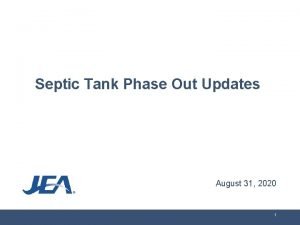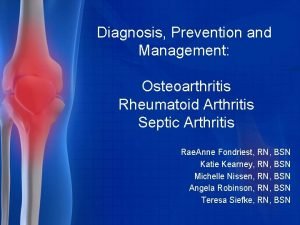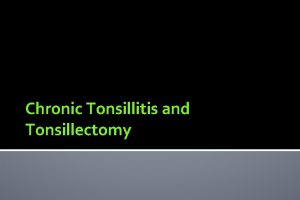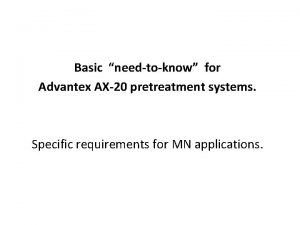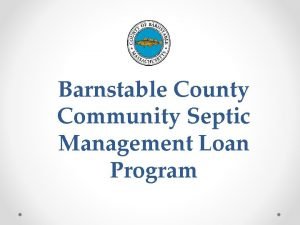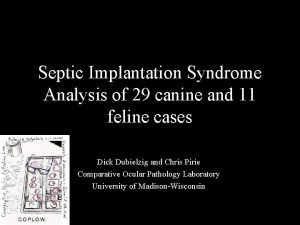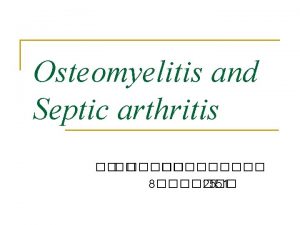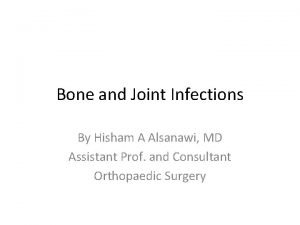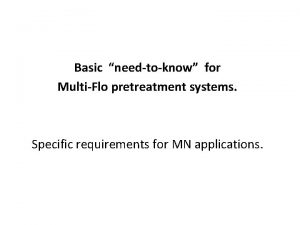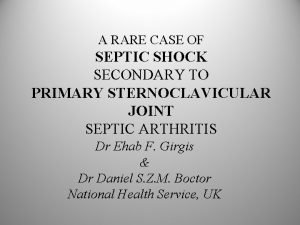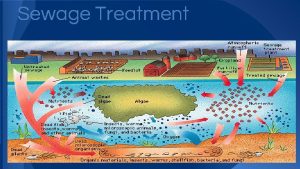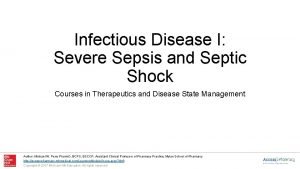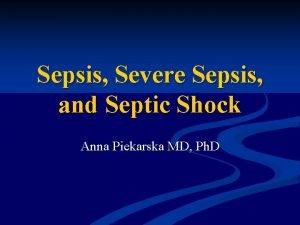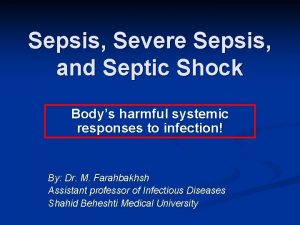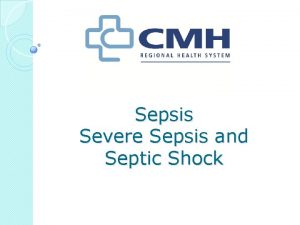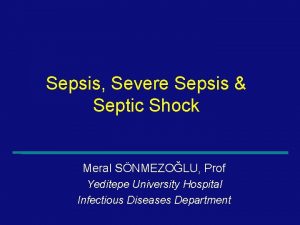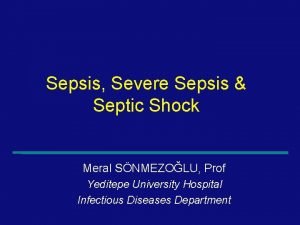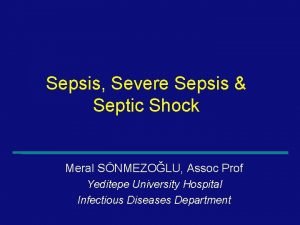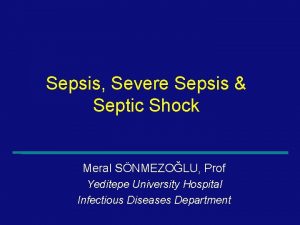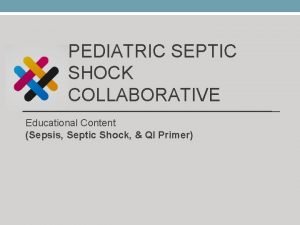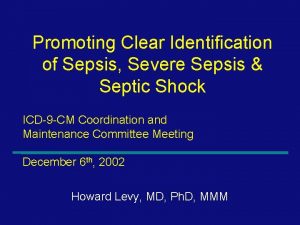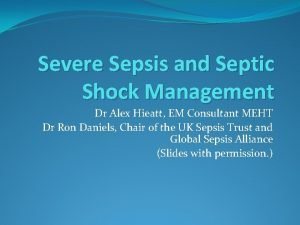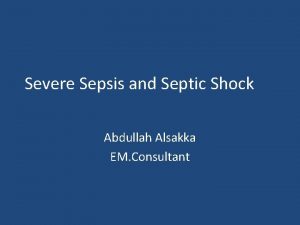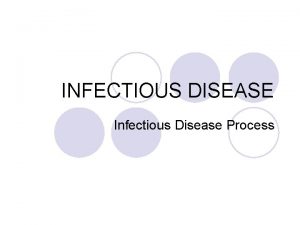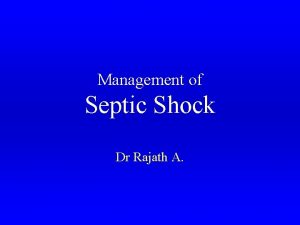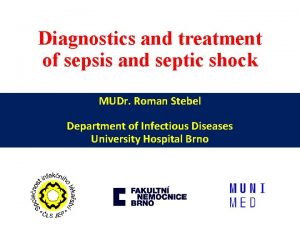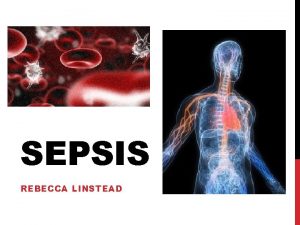Infectious Disease I Severe Sepsis and Septic Shock



































- Slides: 35

Infectious Disease I: Severe Sepsis and Septic Shock Courses in Therapeutics and Disease State Management Author: Michael W. Perry Pharm. D, BCPS, BCCCP; Assistant Clinical Professor of Pharmacy Practice; Mylan School of Pharmacy http: //accesspharmacy. mhmedical. com/Learning. Module. Group. aspx? id=8 Copyright © 2017 Mc. Graw-Hill Education. All rights reserved

Learning Objectives (Slide 1 of 3) • Define the following terms: systemic inflammatory response syndrome, sepsis, severe sepsis, and septic shock • Describe the typical clinical presentation including signs, symptoms, hemodynamic measure, and laboratory tests for each condition above • Describe the microbial pathogens of severe sepsis • Describe the mechanism of sepsis, including the components involving inflammatory cytokines and other mediators and the coagulation system Author: Michael W. Perry Pharm. D, BCPS, BCCCP; Assistant Clinical Professor of Pharmacy Practice; Mylan School of Pharmacy http: //accesspharmacy. mhmedical. com/Learning. Module. Group. aspx? id=8 Copyright © 2017 Mc. Graw-Hill Education. All rights reserved

Learning Objectives (Slide 2 of 3) • Describe the early goal-directed therapy of sepsis • Describe the significance of prompt initiation of broad-spectrum antibiotics • Determine appropriate fluid resuscitation for sepsis with colloids or crystalloids • Recommend an appropriate antibiotic regimen for treatment of sepsis based on patient characteristics and primary site of infection Author: Michael W. Perry Pharm. D, BCPS, BCCCP; Assistant Clinical Professor of Pharmacy Practice; Mylan School of Pharmacy http: //accesspharmacy. mhmedical. com/Learning. Module. Group. aspx? id=8 Copyright © 2017 Mc. Graw-Hill Education. All rights reserved

Learning Objectives (Slide 3 of 3) • Determine the role of vasoactive agents in supporting the physiologic function of a patient with sepsis, and select the appropriate vasoactive agents based on the details of a patient’s condition • Explain the benefits of glycemic control in patients with sepsis • Recommend the appropriate use of corticosteroids in severe sepsis and septic shock • Describe an appropriate monitoring program for patients with sepsis Author: Michael W. Perry Pharm. D, BCPS, BCCCP; Assistant Clinical Professor of Pharmacy Practice; Mylan School of Pharmacy http: //accesspharmacy. mhmedical. com/Learning. Module. Group. aspx? id=8 Copyright © 2017 Mc. Graw-Hill Education. All rights reserved

Required and Recommended Readings Required Reading • Kang-Birken S. Chapter 97. Severe Sepsis and Septic Shock. In: Di. Piro JT, Talbert RL, Yee GC, Matzke GR, Wells BG, Posey L. eds. Pharmacotherapy: A Pathophysiologic Approach, 9 e. New York, NY: Mc. Graw-Hill; 2014. Recommended Reading • Howell MD, Davis AM. Management of Sepsis and Septic Shock. JAMA. 2017; 317(8): 847 -848. • Singer M, Deutschman CS, Seymour CW, Shankar-Hari M, Annane D, Bauer M, Bellomo R, Bernard GR, Chiche J, Coopersmith CM, Hotchkiss RS, Levy MM, Marshall JC, Martin GS, Opal SM, Rubenfeld GD, van der Poll T, Vincent J, Angus DC. The Third International Consensus Definitions for Sepsis and Septic Shock (Sepsis-3). JAMA. 2016; 315(8): 801 -810. • Dellinger RP, Schorr CA, Levy MM. A users’ guide to the 2016 surviving sepsis guidelines. Crit Care Med. 2017; 45(3): 381 -5. Author: Michael W. Perry Pharm. D, BCPS, BCCCP; Assistant Clinical Professor of Pharmacy Practice; Mylan School of Pharmacy http: //accesspharmacy. mhmedical. com/Learning. Module. Group. aspx? id=8 Copyright © 2017 Mc. Graw-Hill Education. All rights reserved

Overview • Sepsis is the primary cause of death from infection • Sepsis and severe sepsis continue to pose major healthcare burden • The Surviving Sepsis campaign was founded in 2002 to reduce mortality from sepsis by 25% in 5 years • Sepsis should be defined as life-threatening organ dysfunction caused by a dysregulated host response to infection Author: Michael W. Perry Pharm. D, BCPS, BCCCP; Assistant Clinical Professor of Pharmacy Practice; Mylan School of Pharmacy http: //accesspharmacy. mhmedical. com/Learning. Module. Group. aspx? id=8 Copyright © 2017 Mc. Graw-Hill Education. All rights reserved

Outdated Definitions • Sepsis • Confirmed or suspected infection PLUS • Systemic manifestation of infection (2 or more SIRS criteria) • Severe sepsis : sepsis associated with one of the following • organ dysfunction • tissue hypoperfusion • Septic shock : sepsis-induced hypotension persisting despite adequate fluid resuscitation • Systemic Inflammatory Response Syndrome (SIRS) • Temperature < 36° C or > 38. 3° C • Heart Rate > 90 bpm • Respiratory Rate > 20 breaths/min • White Blood Cell Count > 12, 000 or < 4, 000 cells/mm 3 or > 10% bands Author: Michael W. Perry Pharm. D, BCPS, BCCCP; Assistant Clinical Professor of Pharmacy Practice; Mylan School of Pharmacy http: //accesspharmacy. mhmedical. com/Learning. Module. Group. aspx? id=8 Copyright © 2017 Mc. Graw-Hill Education. All rights reserved

Current Definitions • Sepsis is defined as life-threatening organ dysfunction caused by a dysregulated host response to infection • Organ dysfunction can be identified as an acute change in total Sequential [Sepsis-related] Organ Failure Assessment (SOFA) score ≥ 2 points consequent to the infection • Patients with suspected infection who are likely to have a prolonged ICU stay or to die in the hospital can be promptly identified at the bedside with quick SOFA (q. SOFA) • Septic shock is a subset of sepsis in which underlying circulatory and cellular/metabolic abnormalities are profound enough to substantially increase mortality. • Despite adequate volume resuscitation • Hypotension persists requiring vasopressors to maintain mean arterial pressure ≥ 65 mm Hg • Serum lactate level >2 mmol/L (18 mg/d. L) Author: Michael W. Perry Pharm. D, BCPS, BCCCP; Assistant Clinical Professor of Pharmacy Practice; Mylan School of Pharmacy http: //accesspharmacy. mhmedical. com/Learning. Module. Group. aspx? id=8 Copyright © 2017 Mc. Graw-Hill Education. All rights reserved

Identifying Sepsis (Slide 1 of 2) Sequential Organ Failure Assessment (SOFA) score System Score 0 1 2 3 4 ≥ 400 < 300 < 200 with respiratory support < 100 with respiratory support ≥ 150 <100 <50 <20 Bilirubin, mg/d. L <1. 2 -1. 9 2. 0 -5. 9 6. 0 -11. 9 >12. 0 Cardiovascular MAP≥ 70 mm. Hg MAP<70 mm. Hg Dopamine < 5 or dobutamine any doseb Dopamine < 5. 1 -15 or epinephrine ≤ 0. 1 or norepinephrine ≤ 0. 1 b Dopamine >15 or epinephrine >0. 1 or norepinephrine > 0. 1 b 15 13 -14 10 -12 6 -9 <6 <1. 2 -1. 9 2. 0 -3. 4 3. 5 -4. 9 >5 <500 <200 Respiration Pa. O 2/Fi. O 2, mm. Hg Coagulation Platelets, x 103 /μL Liver Central Nervous System Glasgow Coma Scale Renal Creatinine, mg/d. L Urine Output, ml/d Author: Michael W. Perry Pharm. D, BCPS, BCCCP; Assistant Clinical Professor of Pharmacy Practice; Mylan School of Pharmacy http: //accesspharmacy. mhmedical. com/Learning. Module. Group. aspx? id=8 Copyright © 2017 Mc. Graw-Hill Education. All rights reserved

Identifying Sepsis (Slide 2 of 2) quick Sepsis-related Organ Failure Assessment • q. SOFA measurement • Altered mental status • Fast Respiratory rate • Low Blood Pressure • Patients presenting with of 2 or more of the above criteria associated with a greater risk of poor outcomes • The baseline SOFA score can be assumed to be zero in patients not known to have preexisting organ dysfunction Author: Michael W. Perry Pharm. D, BCPS, BCCCP; Assistant Clinical Professor of Pharmacy Practice; Mylan School of Pharmacy http: //accesspharmacy. mhmedical. com/Learning. Module. Group. aspx? id=8 Copyright © 2017 Mc. Graw-Hill Education. All rights reserved

Most Common Pathogens / Sites of Infections • Gram-Positive Bacterial Sepsis • • Staphylococcus aureus Streptococcus pneumoniae coagulase-negative staphylococci Enterococcus species • Gram-Negative Bacterial Sepsis • • Escherichia coli Klebsiella species Pseudomonas aeruginosa Serratia species Enterobacter species Proteus species Acinetobacter • Anaerobic and Miscellaneous Bacterial Sepsis • Bacteroides fragilis • Clostridium species • Sites of infections • Most common • • • Respiratory Tract Intraabdominal Space Urinary tract • Can occur from an infection anywhere on the body • Risk Factors • • • Older age Male gender Nonwhite ethnic origin in north Americas Comorbid diseases Malignancy Immunodeficiency or immunocompromised state Chronic organ failure Alcohol dependence Genetic factors • Fungal Sepsis • Candida albicans • Non-albicans Candida species Author: Michael W. Perry Pharm. D, BCPS, BCCCP; Assistant Clinical Professor of Pharmacy Practice; Mylan School of Pharmacy http: //accesspharmacy. mhmedical. com/Learning. Module. Group. aspx? id=8 Copyright © 2017 Mc. Graw-Hill Education. All rights reserved

Cellular Components for Initiating the Inflammatory Process • Lipopolysaccharide • Component of the gram-negative bacterial cell wall • Released during cell lysis • Highly immunoreactive • Activates macrophages • Trigger inflammatory cascades • Exotoxin peptidoglycan • Component of gram-positive bacterial cell wall • Less immunoreactive than lipopolysaccharide • Activates macrophages • Trigger inflammatory cascades Author: Michael W. Perry Pharm. D, BCPS, BCCCP; Assistant Clinical Professor of Pharmacy Practice; Mylan School of Pharmacy http: //accesspharmacy. mhmedical. com/Learning. Module. Group. aspx? id=8 Copyright © 2017 Mc. Graw-Hill Education. All rights reserved

Pro- and Anti-inflammatory Mediators • Pro-inflammatory mediators are released by activated macrophages • tumor necrosis factor-α (TNF-α) • interleukin-1 (IL-1) • interleukin-6 (IL-6) • Anti-inflammatory mediators inhibit the production of the proinflammatory cytokines and down regulate some inflammatory cell • interleukin-1 receptor antagonist (IL-1 RA) • interleukin-4 (IL-4) • interleukin-10 (IL-10) • Link: Image on the balance between pro- and antiinflammatory mediators Author: Michael W. Perry Pharm. D, BCPS, BCCCP; Assistant Clinical Professor of Pharmacy Practice; Mylan School of Pharmacy http: //accesspharmacy. mhmedical. com/Learning. Module. Group. aspx? id=8 Copyright © 2017 Mc. Graw-Hill Education. All rights reserved

Clinical Presentation Early Sepsis Fever or hypothermia Rigors, chills Tachycardia Tachypnea Nausea, vomiting Hyperglycemia Myalgias Lethargy, malaise Proteinuria Hypoxia Leukocytosis Hyperbilirubinemia Late Sepsis Lactic acidosis Oliguria Leukopenia DIC Myocardial depression Pulmonary edema Hypotension (shock) Hypoglycemia Azotemia Thrombocytopenia ARDS GI hemorrhage Coma Author: Michael W. Perry Pharm. D, BCPS, BCCCP; Assistant Clinical Professor of Pharmacy Practice; Mylan School of Pharmacy http: //accesspharmacy. mhmedical. com/Learning. Module. Group. aspx? id=8 Copyright © 2017 Mc. Graw-Hill Education. All rights reserved

Mortality Related to the Number of Failing Organs Author: Michael W. Perry Pharm. D, BCPS, BCCCP; Assistant Clinical Professor of Pharmacy Practice; Mylan School of Pharmacy http: //accesspharmacy. mhmedical. com/Learning. Module. Group. aspx? id=8 Copyright © 2017 Mc. Graw-Hill Education. All rights reserved

Treatment Overview • Early Identification and treatment of sepsis • Screen patients with history of new infection for signs of organ dysfunction • SOFA • q. SOFA • Empiric combination antibiotic therapy within 1 hour of diagnosis • Hemodynamic support • Fluid resuscitation • Vasopressors • Corticosteroids • Routine microbiologic cultures prior to antibiotic therapy if possible Author: Michael W. Perry Pharm. D, BCPS, BCCCP; Assistant Clinical Professor of Pharmacy Practice; Mylan School of Pharmacy http: //accesspharmacy. mhmedical. com/Learning. Module. Group. aspx? id=8 Copyright © 2017 Mc. Graw-Hill Education. All rights reserved

Nonpharmacological Treatment • Elimination of the Source of Infection • • Remove infected catheters Remove urinary catheters Surgical debridement of skin and soft tissue infections Surgical intervention on suspected intraabdominal pathologies • Respiratory Support • Oxygen • Mechanical ventilation Author: Michael W. Perry Pharm. D, BCPS, BCCCP; Assistant Clinical Professor of Pharmacy Practice; Mylan School of Pharmacy http: //accesspharmacy. mhmedical. com/Learning. Module. Group. aspx? id=8 Copyright © 2017 Mc. Graw-Hill Education. All rights reserved

Empiric Antimicrobial Regimens in Sepsis Antimicrobial Regimen Infection (Site or Type) Urinary tract Respiratory tract Intraabdominal Skin/soft tissue Catheter-related Unknown Fungal Community-acquired Ceftriaxone or ciprofloxacin/levofloxacin Levofloxacina/moxifloxacin or ceftriaxone + clarithromycin/azithromycin Ertapenem or tigecycline or ciprofloxacin/levofloxacin + metronidazole Vancomycin or linezolid or daptomycin Hospital-acquired Ciprofloxacin/levofloxacin or ceftriaxone or ceftazidime Piperacillin/tazobactam or ceftazidime or cefepime + levofloxacin/ciprofloxacin or aminoglycoside Piperacillin/tazobactam or carbapenemb Vancomycin + piperacillin/tazobactam Vancomycin Piperacillin/tazobactam ±vancomycin not gentamicin or ceftazidime/ cefepime or imipenem/meropenem Fluconazole or caspofungin or anidulafungin or micafungin Author: Michael W. Perry Pharm. D, BCPS, BCCCP; Assistant Clinical Professor of Pharmacy Practice; Mylan School of Pharmacy http: //accesspharmacy. mhmedical. com/Learning. Module. Group. aspx? id=8 Copyright © 2017 Mc. Graw-Hill Education. All rights reserved

Hemodynamic Support • Fluid Resuscitation • Vasopressors • Norepinephrine • Vasopressin • Epinephrine • Corticosteroids Author: Michael W. Perry Pharm. D, BCPS, BCCCP; Assistant Clinical Professor of Pharmacy Practice; Mylan School of Pharmacy http: //accesspharmacy. mhmedical. com/Learning. Module. Group. aspx? id=8 Copyright © 2017 Mc. Graw-Hill Education. All rights reserved

Fluid Resuscitation (Slide 1 of 4) • Previous recommendation set goals of fluid resuscitation of a central venous pressure of 8 -12 mm. Hg (12– 15 if ventilated ) • Current recommendation aggressive re-hydration during first 3 hrs • Administer 30 ml/kg of crystalloid in response to • Sepsis-induced hypotension • lactate > 4 mmol/L • 5% Albumin may be considered in patients require large volumes of crystalloid therapy • Hypotension (MAP < 65 mm. Hg) after adequate fluid resuscitation will guide furtherapy Author: Michael W. Perry Pharm. D, BCPS, BCCCP; Assistant Clinical Professor of Pharmacy Practice; Mylan School of Pharmacy http: //accesspharmacy. mhmedical. com/Learning. Module. Group. aspx? id=8 Copyright © 2017 Mc. Graw-Hill Education. All rights reserved

Fluid Resuscitation (Slide 2 of 4) IV Fluid Infused Volume Equivalent Intravascular (m. L) Volume Expansion (m. L) NS 1000 250 LR 1000 250 D 5 W 1000 100 Albumin 5% 500 Albumin 25% 100 500 Hetastarch 6% 500 D 5 W = 5% dextrose; IV = intravenous; LR = lactated Ringers; NS = normal saline. Author: Michael W. Perry Pharm. D, BCPS, BCCCP; Assistant Clinical Professor of Pharmacy Practice; Mylan School of Pharmacy http: //accesspharmacy. mhmedical. com/Learning. Module. Group. aspx? id=8 Copyright © 2017 Mc. Graw-Hill Education. All rights reserved

Fluid Resuscitation (Slide 3 of 4) IV Fluid Infused Volume Equivalent Intravascular (m. L) Volume Expansion (m. L) NS 1000 250 LR 1000 250 D 5 W 1000 100 Albumin 5% 500 Albumin 25% 100 500 Hetastarch 6% 500 D 5 W = 5% dextrose; IV = intravenous; LR = lactated Ringers; NS = normal saline. Author: Michael W. Perry Pharm. D, BCPS, BCCCP; Assistant Clinical Professor of Pharmacy Practice; Mylan School of Pharmacy http: //accesspharmacy. mhmedical. com/Learning. Module. Group. aspx? id=8 Copyright © 2017 Mc. Graw-Hill Education. All rights reserved

Fluid Resuscitation (Slide 4 of 4) Crystalloid • 0. 9% Na. Cl • Lactated Ringers • Contains physiologic electrolytes • Lactate content rapidly metabolized • 6 -10 liters of crystalloid typically required Colloids • 5 % Albumin • Human derived product • Increased cost compared to crystalloid • Hemodilution • Decrease in colloid osmotic pressure • Edema • Pulmonary • Systemic Author: Michael W. Perry Pharm. D, BCPS, BCCCP; Assistant Clinical Professor of Pharmacy Practice; Mylan School of Pharmacy http: //accesspharmacy. mhmedical. com/Learning. Module. Group. aspx? id=8 Copyright © 2017 Mc. Graw-Hill Education. All rights reserved

Crystalloid vs. Colloid • Saline versus Albumin Fluid Evaluation (SAFE) • Albumin was safe and equally as effective as crystalloid • 6, 997 patients randomized • No difference in 28 day mortality • Albumin 20. 9% • Saline 21. 1% • Increased edema with crystalloids • Lower cost with crystalloids Author: Michael W. Perry Pharm. D, BCPS, BCCCP; Assistant Clinical Professor of Pharmacy Practice; Mylan School of Pharmacy http: //accesspharmacy. mhmedical. com/Learning. Module. Group. aspx? id=8 Copyright © 2017 Mc. Graw-Hill Education. All rights reserved

Hemodynamic Support: Vasopressors • Initiate AFTER adequate fluid therapy and MAP < 65 mm Hg • Start with Norepinephrine • 35 to 90 μg/min to achieve target MAP > 65 mm. Hg • If patient fails to respond to norepinephrine and the MAP < 65 • Add vasopressin 0. 03 units/min to achieve target MAP > 65 mm. Hg • Could consider IV corticosteroids • If patient fails to respond both norepinephrine and vasopressin and the MAP < 65 • Add epinephrine 20 -50 μg/min to achieve target MAP > 65 mm. Hg • Add IV corticosteroids • If patient fails to respond both norepinephrine and vasopressin and epinephrine and the MAP < 65 • Add phenylephrine up to 200 to 300 μg/min to achieve MAP target Author: Michael W. Perry Pharm. D, BCPS, BCCCP; Assistant Clinical Professor of Pharmacy Practice; Mylan School of Pharmacy http: //accesspharmacy. mhmedical. com/Learning. Module. Group. aspx? id=8 Copyright © 2017 Mc. Graw-Hill Education. All rights reserved

Receptor Activity of Cardiovascular Agents Commonly Used in Septic Shock Agent α 1 α 2 β 1 β 2 Dopaminergic Dopamine ++/+++ ? ++++ ++ ++++ Dobutamine + + ++++ ++ 0 Norepinephrine +++ +++ +/++ 0 Phenylephrine ++/+++ + ? 0 0 Epinephrine ++++ 0 α 1, α 1 -adrenergic receptor; α 2, α 2 -adrenergic receptor; β 1, β 1 -adrenergic receptor; β 2, β 2 -adrenergic receptor; 0, no activity; ++++, maximal activity; ? , unknown activity Author: Michael W. Perry Pharm. D, BCPS, BCCCP; Assistant Clinical Professor of Pharmacy Practice; Mylan School of Pharmacy http: //accesspharmacy. mhmedical. com/Learning. Module. Group. aspx? id=8 Copyright © 2017 Mc. Graw-Hill Education. All rights reserved

Hemodynamic Support: Norepinephrine (Levophed) • Drug of first choice in sepsis • Strong vasoconstrictor with weak inotropic effects • Strong affinity for the α 1 receptor • Weak affinity for the β 2 receptor • Dose 2 -20 mcg/min • t ½ = 1 -2 minutes Author: Michael W. Perry Pharm. D, BCPS, BCCCP; Assistant Clinical Professor of Pharmacy Practice; Mylan School of Pharmacy http: //accesspharmacy. mhmedical. com/Learning. Module. Group. aspx? id=8 Copyright © 2017 Mc. Graw-Hill Education. All rights reserved

Hemodynamic Support: Vasopressin • Peptide hormone • Synthesized in hypothalamus • Stored in pituitary gland • Mechanism of Action • Binds to V 1 receptors causing vascular smooth muscle constriction • Increases response to catecholamine • Recommended to add to norepinephrine therapy to increase the MAP or decrease the norepinephrine dosage • Low-dose vasopressin replacement • Use in catecholamine-resistant septic patients • Decrease catecholamine requirements • 0. 01 -0. 03 units/min (DO NOT TITRATE) Author: Michael W. Perry Pharm. D, BCPS, BCCCP; Assistant Clinical Professor of Pharmacy Practice; Mylan School of Pharmacy http: //accesspharmacy. mhmedical. com/Learning. Module. Group. aspx? id=8 Copyright © 2017 Mc. Graw-Hill Education. All rights reserved

Hemodynamic Support: Epinephrine • Use in septic patients unresponsive to traditional vasopressors • Positive inotrope with vasoconstrictive effects • Strong affinity for the α 1 receptor • Strong affinity for the β 2 receptor • Strong affinity for the β 1 receptor • 1 -20 mcg/min • t ½ = 1 -2 minutes Author: Michael W. Perry Pharm. D, BCPS, BCCCP; Assistant Clinical Professor of Pharmacy Practice; Mylan School of Pharmacy http: //accesspharmacy. mhmedical. com/Learning. Module. Group. aspx? id=8 Copyright © 2017 Mc. Graw-Hill Education. All rights reserved

Hemodynamic Support: Phenylephrine (Neo) • Not recommended in sepsis treatment unless patient has significant tachyarrhythmia • Strong vasoconstrictor • Strong affinity for the α 1 receptor • 20 -200 mcg/min • T ½ = 1 -2 minutes Author: Michael W. Perry Pharm. D, BCPS, BCCCP; Assistant Clinical Professor of Pharmacy Practice; Mylan School of Pharmacy http: //accesspharmacy. mhmedical. com/Learning. Module. Group. aspx? id=8 Copyright © 2017 Mc. Graw-Hill Education. All rights reserved

Hemodynamic Support: Dopamine • Use instead of norepinephrine in specific patients • Bradycardia • Positive inotrope with vasoconstrictive effects • Strong affinity for the β 1 receptor • Dose dependent affinity for the α 1 receptor • Dose: 5 -10 mcg/kg/min • t ½ = 1 -2 minutes Author: Michael W. Perry Pharm. D, BCPS, BCCCP; Assistant Clinical Professor of Pharmacy Practice; Mylan School of Pharmacy http: //accesspharmacy. mhmedical. com/Learning. Module. Group. aspx? id=8 Copyright © 2017 Mc. Graw-Hill Education. All rights reserved

Hemodynamic Support: Corticosteroids • Cortisol levels vary widely in patients with septic shock, and some studies have suggested increased mortality associated with both low and high serum cortisol levels • Steroid use is controversial in the management of sepsis • Corticosteroids should be reserved for patients who continue to be hypotensive despite adequate fluids and vasopressor therapy • Hydrocortisone 50 mg IV q 6 H Author: Michael W. Perry Pharm. D, BCPS, BCCCP; Assistant Clinical Professor of Pharmacy Practice; Mylan School of Pharmacy http: //accesspharmacy. mhmedical. com/Learning. Module. Group. aspx? id=8 Copyright © 2017 Mc. Graw-Hill Education. All rights reserved

Overall Monitoring of Sepsis • Evaluate for improving signs and symptoms of initiating infection • Closely monitor hemodynamic parameters • • MAP Central venous pressure if available Serum lactate can be a marker of tissue perfusion Supportive care measure intensity Author: Michael W. Perry Pharm. D, BCPS, BCCCP; Assistant Clinical Professor of Pharmacy Practice; Mylan School of Pharmacy http: //accesspharmacy. mhmedical. com/Learning. Module. Group. aspx? id=8 Copyright © 2017 Mc. Graw-Hill Education. All rights reserved

Summary • Patients presenting with severe sepsis and septic shock are critically ill and their management in an intensive care setting can be overwhelming • Early Identification and treatment is the mainstay of therapy • • Monitoring for infection and signs of organ dysfunction Early identification of pathogens/ source control Antibiotic therapy within 1 hour if possible Hemodynamic support • Fluid resuscitation (30 ml/kg) over 3 hours • Vasopressors • Steroids Author: Michael W. Perry Pharm. D, BCPS, BCCCP; Assistant Clinical Professor of Pharmacy Practice; Mylan School of Pharmacy http: //accesspharmacy. mhmedical. com/Learning. Module. Group. aspx? id=8 Copyright © 2017 Mc. Graw-Hill Education. All rights reserved

References • Kang-Birken S. Chapter 97. Severe Sepsis and Septic Shock. In: Di. Piro JT, Talbert RL, Yee GC, Matzke GR, Wells BG, Posey L. eds. Pharmacotherapy: A Pathophysiologic Approach, 9 e. New York, NY: Mc. Graw-Hill; 2014. • Howell MD, Davis AM. Management of Sepsis and Septic Shock. JAMA. 2017; 317(8): 847 -848. • Singer M, Deutschman CS, Seymour CW, Shankar-Hari M, Annane D, Bauer M, Bellomo R, Bernard GR, Chiche J, Coopersmith CM, Hotchkiss RS, Levy MM, Marshall JC, Martin GS, Opal SM, Rubenfeld GD, van der Poll T, Vincent J, Angus DC. The Third International Consensus Definitions for Sepsis and Septic Shock (Sepsis-3). JAMA. 2016; 315(8): 801 -810. • Dellinger RP, Schorr CA, Levy MM. A users’ guide to the 2016 surviving sepsis guidelines. Crit Care Med. 2017; 45(3): 381 -5. Author: Michael W. Perry Pharm. D, BCPS, BCCCP; Assistant Clinical Professor of Pharmacy Practice; Mylan School of Pharmacy http: //accesspharmacy. mhmedical. com/Learning. Module. Group. aspx? id=8 Copyright © 2017 Mc. Graw-Hill Education. All rights reserved
 Quick sofa escala
Quick sofa escala Chapter 26 infectious disease prevention and control
Chapter 26 infectious disease prevention and control Infectious disease quality controls
Infectious disease quality controls Types of infection
Types of infection Stages of infectious disease
Stages of infectious disease Stridor
Stridor Infectious disease
Infectious disease Hennepin county infectious disease manual
Hennepin county infectious disease manual What is the smallest infectious disease agent
What is the smallest infectious disease agent What causes sepsis
What causes sepsis Spinal shock vs neurogenic shock
Spinal shock vs neurogenic shock Normovolemico
Normovolemico Spinal shock vs neurogenic shock
Spinal shock vs neurogenic shock Spinal shock vs neurogenic shock
Spinal shock vs neurogenic shock Subacute combined degeneration
Subacute combined degeneration Bharathi viswanathan
Bharathi viswanathan Certain infectious and parasitic diseases
Certain infectious and parasitic diseases Hpps logo
Hpps logo Jea septic tank phase out
Jea septic tank phase out Septic tank contamination groundwater
Septic tank contamination groundwater Boutonniere nodes
Boutonniere nodes Septic systems indianapolis
Septic systems indianapolis Ervin moore sign
Ervin moore sign Advantex septic system reviews
Advantex septic system reviews Barnstable septic loan
Barnstable septic loan Septic implantation syndrome
Septic implantation syndrome Septic arthritis complications
Septic arthritis complications Panhandle health septic
Panhandle health septic Septic arthritis antibiotics
Septic arthritis antibiotics Septic arthritis antibiotics
Septic arthritis antibiotics Bat septic
Bat septic Multi flo aerator replacement
Multi flo aerator replacement Puraflo peat septic system
Puraflo peat septic system Septic arthritis complications
Septic arthritis complications Doc's septic tank cleaning
Doc's septic tank cleaning Enthesitis
Enthesitis
